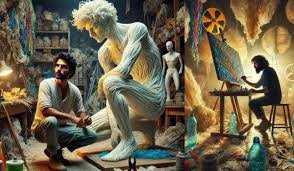Art, at its core, is a deeply personal form of expression that can evoke emotions, challenge societal norms, and question our perceptions of reality. One artist who embodies this philosophy is Khalil Chishtee, a Pakistani-born sculptor and contemporary artist whose thought-provoking work pushes boundaries and invites viewers to confront deeper existential issues. Chishtee’s statement, “Not all art is beauty,” serves as both a challenge and an invitation to explore art as something more than just an object of visual pleasure. His pieces encourage a shift in how we define beauty and art, https-multigrafico-com-khalil-chishtee-no-todo-el-arte-es-belleza/ expanding the dialogue to encompass a wide range of human experiences, emotions, and philosophical questions.
In this article, we will delve into the life, work, and philosophy of Khalil Chishtee, examining how his art redefines traditional concepts of beauty and opens a new dimension of artistic thought.
Khalil Chishtee: The Man Behind the Art
Khalil Chishtee was born in Pakistan, where he studied and practiced art before moving to the United States. His work is deeply influenced by his multicultural background, combining elements from Eastern and Western artistic traditions. Chishtee’s creations are often centered on human figures and emotions, using unconventional materials and forms to convey complex ideas about life, death, identity, and time.
Trained as a sculptor, Chishtee’s medium of choice is often discarded plastic, such as bags and waste materials. This choice of material is significant, as it ties into his broader commentary on consumerism, waste, and the impermanence of life. Chishtee repurposes what society deems as trash into evocative, sometimes haunting figures, imbuing his work with a deeper sense of meaning.
An Artistic Journey Rooted in Philosophy
Chishtee’s philosophy on art is grounded in existentialism, a movement that explores the human condition and our individual experience in a seemingly indifferent or absurd universe. The artist uses sculpture as a tool to explore the transient nature of existence, while his figures often appear to be in a state of dissolution or imperfection. For Chishtee, this lack of perfection is integral to his message: life is not about static ideals, but about the constantly evolving, imperfect nature of reality.
In an interview, Chishtee said, “Not all art is beauty because not all of life is beautiful. Art, like life, is messy, chaotic, and full of contradictions. It’s about more than just creating something visually pleasing—it’s about evoking thought, feeling, and even discomfort.”
The Role of Imperfection in Chishtee’s Work
One of the central themes of Chishtee’s art is imperfection. He deliberately avoids the pursuit of aesthetic perfection, embracing instead the rough, incomplete, or broken aspects of his creations. This reflects the idea that true beauty lies not in flawless forms,https-multigrafico-com-khalil-chishtee-no-todo-el-arte-es-belleza/ but in the flaws and vulnerabilities that make us human.
His sculptures often depict fragmented or distorted human forms, symbolizing the fragmented nature of human existence. The figures appear to be unraveling or decaying, made from recycled plastic bags that give them a fragile, ephemeral quality. This impermanence mirrors the fleeting nature of life, a recurring theme in Chishtee’s work.
By using waste materials, Chishtee also challenges the traditional notions of what can be considered art. His choice of plastic, a material synonymous with pollution and consumerism, forces viewers to confront uncomfortable truths about environmental degradation and the disposability of modern life. Yet, in his hands, even something as mundane and unsightly as discarded plastic can become a vehicle for profound artistic expression.
Sculpting Existential Questions
Chishtee’s figures often appear as though they are in motion or caught in a moment of transformation. Their bodies are loose, draped in plastic, and appear as if they could fall apart at any moment. This deliberate vulnerability in his sculptures reflects the fragility of human existence and the existential uncertainty we all face.
One of his most notable pieces, titled “Man Carrying His Own Shadow,” depicts a human figure lugging a large, amorphous mass behind him. The sculpture can be interpreted as a metaphor for the emotional baggage we carry with us throughout life—our regrets, memories, and unfulfilled desires. The figure’s struggle with the heavy shadow emphasizes the weight of these experiences and the way they shape our identities.
Through such works, Chishtee engages with the themes of mortality, identity, and self-reflection, asking viewers to question the very essence of their existence. The use of materials that will eventually degrade reinforces the idea that nothing lasts forever, not even the self.
Beauty Beyond Aesthetics: Art as a Medium for Discomfort
While the art world often emphasizes beauty and perfection, Chishtee’s work resists this notion, proposing instead that true art is found in the rawness and discomfort of life. His sculptures are not made to be admired for their aesthetic appeal but rather for the way they provoke thought and emotion. In this way, Chishtee’s work challenges the viewer to redefine what beauty means in the context of art.
This concept resonates deeply with the idea that beauty is subjective and can be found in unlikely places. Chishtee’s sculptures, with their ragged edges and unconventional materials, ask viewers to find beauty in imperfection, decay, and even discomfort. By doing so, he forces us to reconsider the role of art in society—not as something to be passively consumed, but as something that demands active engagement and introspection.
Cultural Context and Global Influence
Although Chishtee’s art is deeply personal, it is also shaped by his cultural background and experiences. Growing up in Pakistan and later moving to the U.S., Chishtee is acutely aware of the cultural tensions that arise from globalization, migration, and identity. His work often reflects the displacement and alienation felt by immigrants and those who exist between cultures.
For example, Chishtee’s sculptures of veiled or faceless figures can be seen as a commentary on the loss of individual identity in a world where cultural homogenization and societal pressures to conform are rampant. These faceless forms may also speak to the experience of marginalization, where people are often reduced to stereotypes or faceless masses in the eyes of society.
At the same time, Chishtee’s work transcends cultural boundaries, touching on universal themes that resonate with audiences around the world. The existential questions he raises about life, death, and identity are not confined to any one culture or context,https-multigrafico-com-khalil-chishtee-no-todo-el-arte-es-belleza/ making his art accessible to a global audience.
The Intersection of Environmentalism and Art
Khalil Chishtee’s use of discarded plastic materials not only serves an artistic purpose but also carries a strong environmental message. In an age where pollution and waste are critical global issues, Chishtee’s sculptures act as a reminder of the impact of consumerism and the culture of disposability.
By repurposing waste into art, Chishtee highlights the potential for transformation and renewal in a world that is constantly throwing things away. His work encourages viewers to rethink their relationship with material objects and consider the long-term consequences of their consumption habits. In this sense, his art functions as a critique of contemporary society and its unsustainable practices.
The Future of Chishtee’s Artistic Legacy
As Khalil Chishtee continues to create, his body of work challenges the conventions of both art and society. By rejecting traditional ideas of beauty and embracing imperfection, he forces us to confront uncomfortable truths about ourselves and the world around us. His use of recycled materials and his focus on existential themes speak to the broader social and environmental issues of our time, making his work not only relevant but also urgent.
In a world that often values appearances over substance, Chishtee’s art reminds us that true beauty lies in authenticity, vulnerability, and the willingness to explore the unknown. His statement, “Not all art is beauty,” encapsulates this idea perfectly, urging us to look beyond the surface and engage with the deeper, often messy, realities of life.
Conclusion: Art as a Reflection of Life’s Complexity
Khalil Chishtee’s work challenges the traditional boundaries of art, offering a new way of thinking about beauty, materials, and the role of the artist in society. By creating sculptures that evoke discomfort, reflection, and existential questioning, Chishtee redefines the purpose of art. His belief that “not all art is beauty” serves as an important reminder that art, like life, is complex, unpredictable, and filled with contradictions.
In embracing imperfection and transience, Chishtee opens the door to a more profound understanding of what it means to be human.https-multigrafico-com-khalil-chishtee-no-todo-el-arte-es-belleza/ His art is not just an object to be admired but a mirror that reflects the fragility, uncertainty, and beauty of existence itself.


